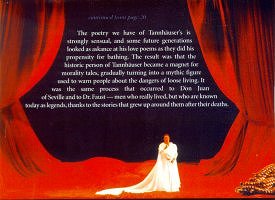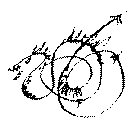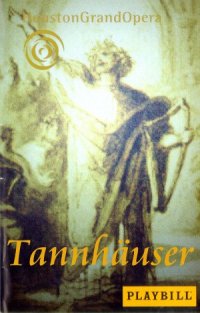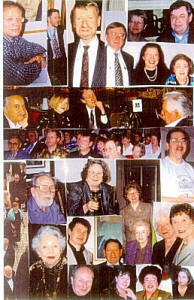|
The
Wagner Society |
|
|
|
FOR IMMEDIATE RELEASE Tannhauser at Houston Grand Opera: A ReviewBrown Theater, Wortham Theater
Center, Houston, Tx
|
|
Venus Tannhauser Wolfram von Eschenbach Elizabeth Landgraf Hermann Conductor Director Set Designer Costume Designer Houston Symphony Orchestra |
The Houston Tannhauser was one of those thrilling performances in which all the pieces come together to form a wonderful whole.
The production itself, by Werner Herzog, was visually impressive, yet with some peculiarities. It looked as if someone must have gotten a bargain on a couple of thousand yards of crinkle silk and gone wild. The Venusburg scene was fully draped with vivid crimson. Two huge billowing panels, floor to ceiling, formed a bower for Venus and Heinrich on stage left, with a kind of drapery tie-back fastening huge maritime rope coils for contrast, in an effort to give the stage picture some definition.

Production photo from Playbill Program
Venus, sung by Michelle de Young, was gowned in the same crimson color - which may have helped minimize her size, since she is a big girl. But her voice was so luscious - a big, rich mezzo with a ringing, free top - that a plump Venus was a small consideration.
Stig Anderson (who had been HGO's Tristan last year) not only looked better this year, maybe because the blonde wig he wore was more becoming than the crew cut he wore last year, but also sounded better than he did a year ago. Lobby scuttle-butt claimed that he had had a cold during the Tristan run, but in any case, his voice sounded fuller and seemed more easily produced this time, showing no vocal fatigue in what is a long, demanding role. As before, his acting was committed and consistent. When he left the Venusberg, all the red silk, which even covered the floor, was suddenly whisked away as if by a giant vacuum cleaner, revealing immense columns with massive pediments. These somber gray columns served well as the setting for the rest of the opera, while the costumes were predominantly white silk.
The knights wore a kind of under suit which also covered their heads with strange, jagged ear holes that made me think that the designer, Franz Blumauer, had intended them to be solid, but then the cast found that they could not hear, so the holes were cut in as an afterthought. I must add this comment - the knights had really weird helmets (one would have called them Ku Klux Klan cones, which is not far off the mark) that were quite large, but then opened like a regular helmet and tilted back. The knights later remove these helmets , of course. As you can see, there was plenty to fill the eye in this production.
One of the peculiarities of sitting on the front row is that you can sometimes see things too clearly. One wonders if so virginal and pure a girl as Elizabeth, sung by Tina Kiberg, would actually wear such a tight fitting white silk gown, thus allowing her nipples to show through so clearly. She also carried a voluminous train which she managed quite well, in spite of the fans apparently placed around the stage to keep the air moving, and thus keep the costumes fluttering in the breeze. Vocally, she was exemplary, as were they all, even if her voice was not a voluptuous sounding one, perhaps suffering a bit in contrast with Miss de Young. Her entrance aria in Act II, Dich teure halle, was not her best moment of the afternoon - she sounded a bit thin - but she warmed up after that and improved throughout the performance.

Production Photo from Playbill Program
Whether the fact that Tina Kiberg is Stig Andersen's real-life wife made any difference, I do not know, but the two played very well off each other. Their initial encounter built wonderful tension, as if they were dying to embrace, but simply could not. She also did a wonderful little bit that I had never seen before. After Tannhauser's first interjection, in which he spurns the idea of love from afar as stated by the First Knight, instead extolling a more sensuous love, she stepped forward, glowing, and even applauded for a moment, until she realized the disapproval of all the others. I thought it was a really telling moment in the drama. After the rest of the exchange, with all the other knights also singing in favor of chaste love, Tannhauser becomes ever more passionate. When they finally threatened to kill him, she rushed out to intervene and give him his chance to redemption. The scene continued to build to a searing intensity that really climaxed the act, partly as a result of Andersen's passion.
The Landgrave was sung by Stephen Milling, who had an ideal sound for the part, with a full, rich reverberating sound in the lower register, so that the bottom notes presented no hurdle. He is also a really tall man who looked right for the ruling presence.
The only less than perfect link in an otherwise perfect cast was baritone Guido Paevatule, who sang Wolfram. However, I think he only suffered in comparison with the rest of the singers, since he was actually quite good. His Ode to the Evening Star in Act III was sung with intelligent, dramatic conviction, even if it seemed to me to lack that last degree of vocal opulence. Also in Act III, Kiberg's prayer to the Madonna was beautifully done, both dramatically and vocally, and Andersen's Rome Narrative was nothing short of a wonder - never the least bit tedious, as it can be in lesser hands.
The only question of the afternoon for me was why, with all this going for it, did I find myself very impressed but not so emotionally moved. At Tannhauser last year in Tulsa, I was in tears for most of the last act! My only supposition is that conductor John Fiore is simply not as inspired with the score as Carol Crawford! I must admit, however, that though I have not considered Fiore to be one of my favorites, by a long shot, that this was some of the best conducting I've heard from him, surely because the Houston Symphony was in the pit. I could not help keep thinking, however, what it might have been if Cristof von Eschenbach had been at the helm, as he was for Tristan last year.
All in all, it was a thrilling afternoon.
Subject: Web Site
SubjectOther: HGO TANNHAUSER review.
Username: A very famous name in classical music
UserEmail: met.org
Date: 27 Jan 2004
Comments: Carroll Staton's review of TANNHAUSER was very unfair to the conductor, John Fiore. He has a long history and experience with Wagner, and for her to poo-poo him like that was disgraceful. The Houston Symphony is wonderful, but they did not play that score so gloriously just by themselves. Fiore had a lot to do with it. If Miss Staton was not as moved as she would have liked to have been in Act III, maybe she should have directed her criticism elsewhere. The conductor is the easy target for uneducated critics, and she really took a cheap shot by slamming one of our best and most unassuming american conductors. She thought it was a great performance, yet she attacks the conductor. Without a great conductor, TANNHAUSER cannot be great! I heard the broadcast, and it was one of the best conducted TANNHAUSERs I have heard in 50 years of opera experience. It is a shame that a nasty and unjustified review like this one is so easily accesible on the web.
Founded in 1992 by Virginia Richey Abdo and Dr. James T. Wheeler, the Wagner Society of Dallas has had an active presence in the musical life of Dallas since that time. As the WSD continues to grow and expand, it is having a wider and wider influence among musicians and performing arts institutions in North Texas, as well as with music lovers throughout the Metroplex area. The Wagner Society of Dallas is now creating a presence on the internet as a tool to promote the music of Richard Wagner, and classical music in general, to the widest possible audience. Through the medium of its own web page, regular meetings, participation in musical events in the Dallas area, and attendance at opera performances across the country and around the world, the Wagner Society of Dallas is becoming an important source of Wagner information on the World Wide Web.
For More Information Contact:
Wagner Society of Dallas
P.O. Box 25201
Dallas, TX 75225-0201
Web Address:
www.WagnerDallas.com
E-Mail:
WSD@WagnerDallas.com
WebMaster:
eflaspo@aol.com



